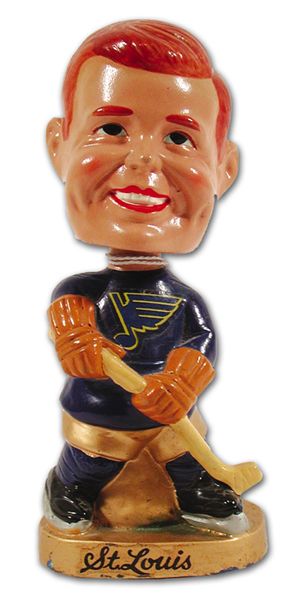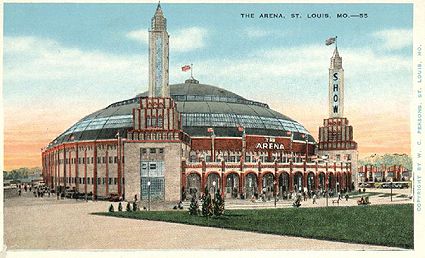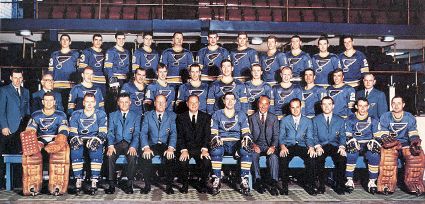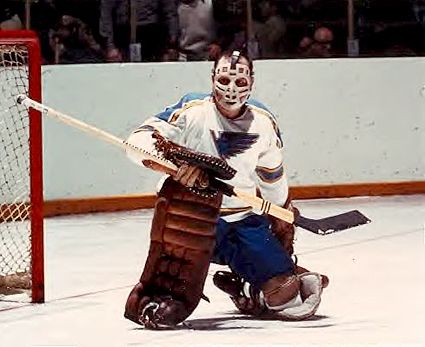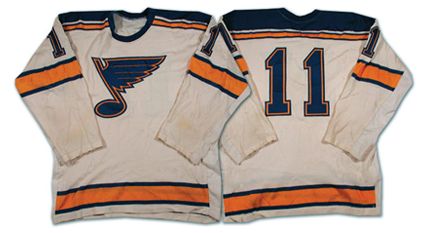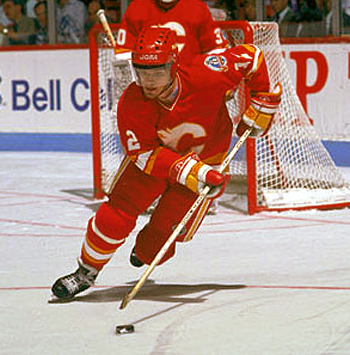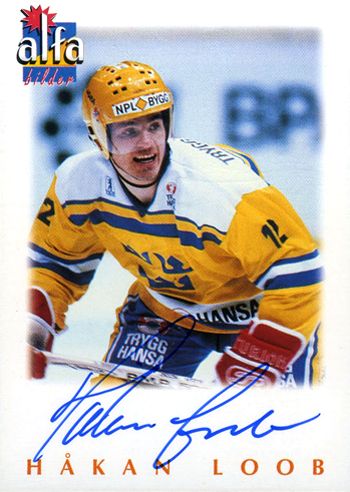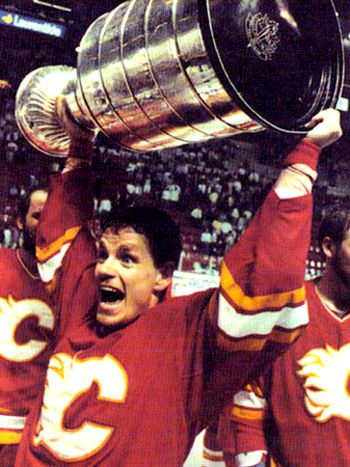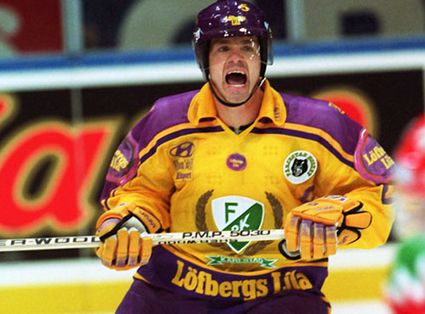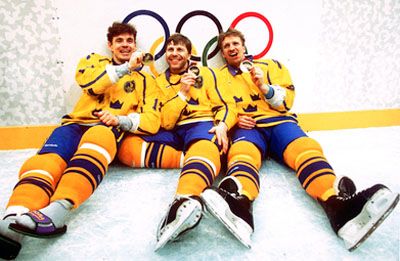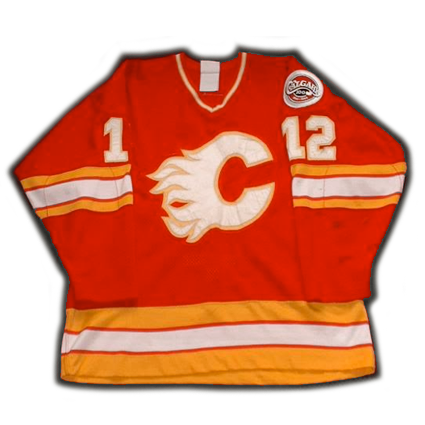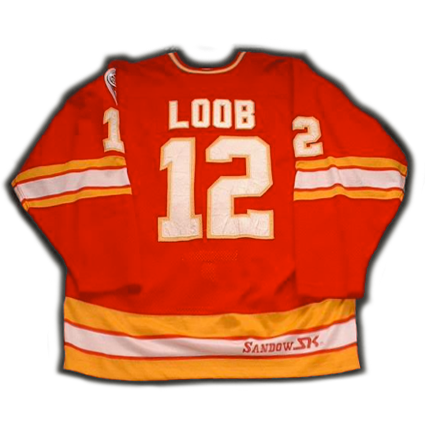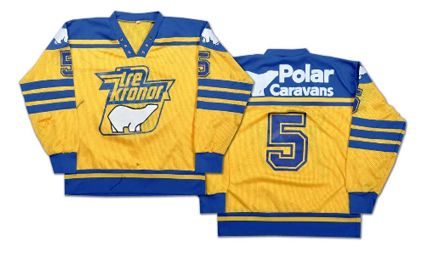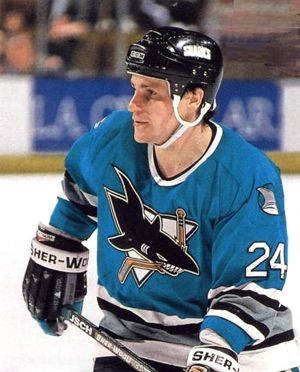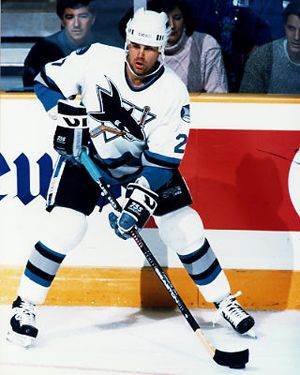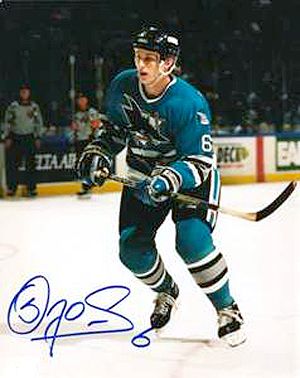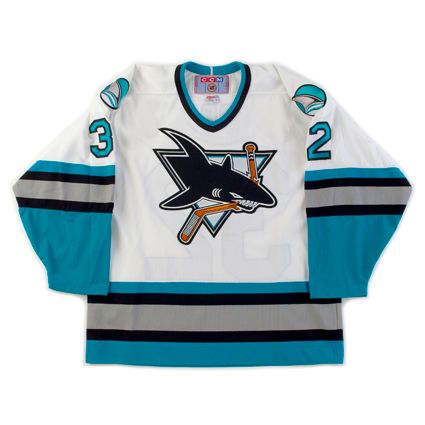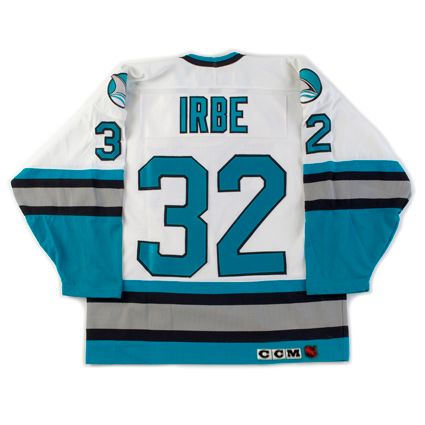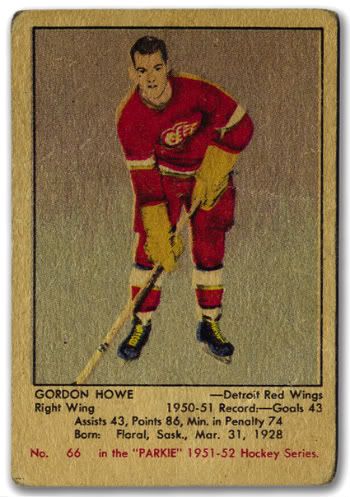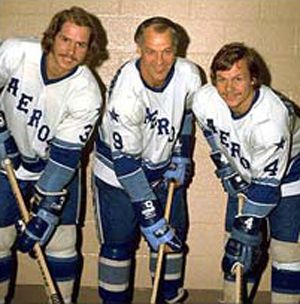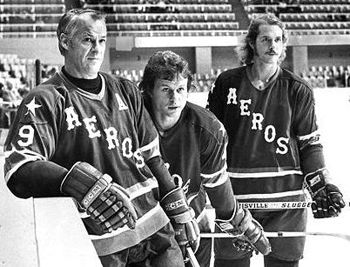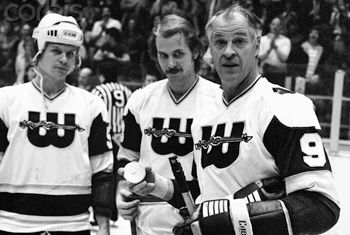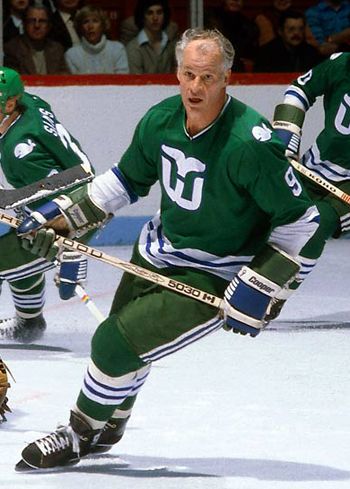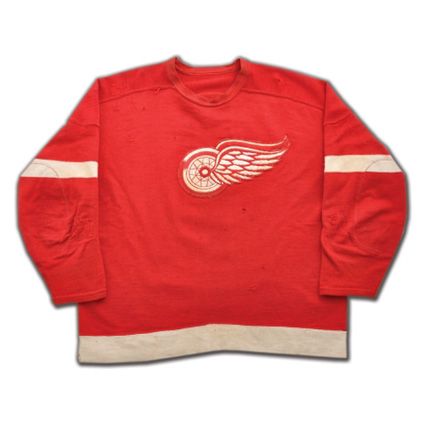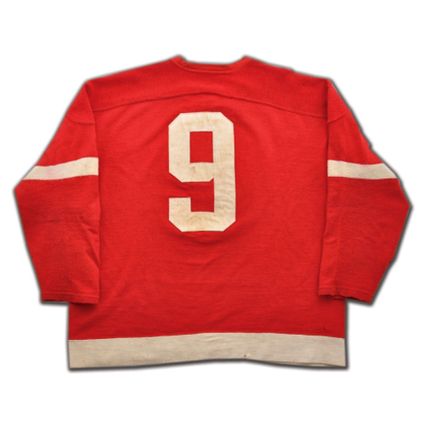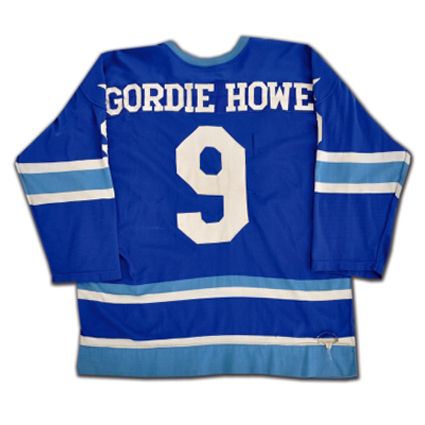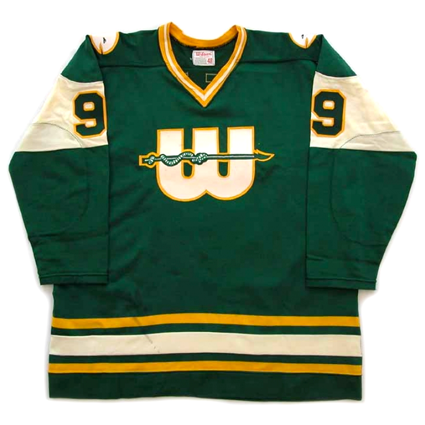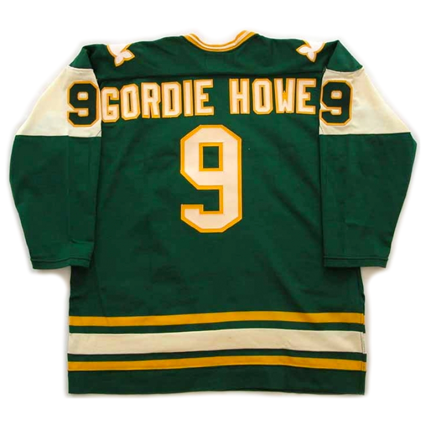While many of the players on the roster were either NHL rookies or players with very limited NHL experience, they were not fresh-faced kids just out of juniors, but grizzled veterans with many seasons of minor league experience who were unable to crack the rosters of the Original 6 era, but who were more than capable of competing in the now 12 team NHL. Some of these players would remain with the Blues for many seasons to come, such as Frank St. Marseille, Gary Sabourin, Bob Plager, Noel Picard and Barclay Plager, who would eventually have his number retired by the Blues.
Friday, April 5, 2013
1967-68 St. Louis Blues Gary Sabourin Jersey
Since the demise of the Brooklyn Americans in 1942, the NHL consisted of just six member teams, commonly referred to as "The Original Six". Finally, following the success of the Los Angeles Dodgers and San Francisco Giants of Major League Baseball, who had moved to the west coast in 1958, the idea of expanding the NHL was first brought up in 1963, partly due to concerns that the Western Hockey League was intending to operate as a major league in the near future and also in hopes of making the league more attractive to American television networks with coast-to-coast appeal.
The original discussions promoted San Francisco and Vancouver as acceptable locations with Los Angeles and St. Louis also as potential candidates in March of 1965.
In February of 1966, applications were received from groups representing Los Angeles, Pittsburgh, Minnesota, Philadelphia, San Francisco, Baltimore, Buffalo and Vancouver. But not St. Louis.
In the end, franchises were awarded to Oakland (across the bay from San Francisco), Los Angeles, Minnesota, Philadelphia, Pittsburgh and, on this date in 1966...
St. Louis!
The decision to exclude Vancouver caught many by surprise, especially those involved in the construction of the brand new Pacific Coliseum in Vancouver, and angered not only the locals, but all of Canada, since the six chosen cities were all in the United States. Various reasons emerged to explain the surprise inclusion of St. Louis, despite the fact there was no formal proposal from a group representing St. Louis.
Reportedly, the Toronto Maple Leafs and Montreal Canadiens did not want to share Canadian TV revenues with a third club and support for any expansion from the Chicago Black Hawks was contingent on the creation of a team in St. Louis, which would result in a near by rival as well as the sale of the run-down St. Louis Arena, which just conveniently happened to be owned by the Chicago Black Hawks ownership group at the time...
The St. Louis Arena
With the franchise now granted, the club's original owners spent several million dollars to massively renovate the arena, which included expanding it's capacity from 12,000 to 15,000 seats.
While Lynn Patrick was the original St. Louis Blues head coach, after a mere 16 games, the legendary Scotty Bowman took over a roster which included veteran players Dickie Moore, leading scorer Red Berenson (51 points in 55 games after arriving in a trade) and goaltender Glenn Hall.
While many of the players on the roster were either NHL rookies or players with very limited NHL experience, they were not fresh-faced kids just out of juniors, but grizzled veterans with many seasons of minor league experience who were unable to crack the rosters of the Original 6 era, but who were more than capable of competing in the now 12 team NHL. Some of these players would remain with the Blues for many seasons to come, such as Frank St. Marseille, Gary Sabourin, Bob Plager, Noel Picard and Barclay Plager, who would eventually have his number retired by the Blues.
While many of the players on the roster were either NHL rookies or players with very limited NHL experience, they were not fresh-faced kids just out of juniors, but grizzled veterans with many seasons of minor league experience who were unable to crack the rosters of the Original 6 era, but who were more than capable of competing in the now 12 team NHL. Some of these players would remain with the Blues for many seasons to come, such as Frank St. Marseille, Gary Sabourin, Bob Plager, Noel Picard and Barclay Plager, who would eventually have his number retired by the Blues.
The 1967-68 St. Louis Blues
That club would play the first game in franchise history on October 11, 1967 when they hosted their fellow expansion brothers the Minnesota North Stars at the Arena in a game which ended in a 2-2 tie.
While the Blues had a rough early going, sinking to a 5-16-2 record, which included a 2-11 stretch in November and early December, the team came together following the coaching change to Bowman on November 20th. From December 9th to the end of January, the Blues reeled off a 13-5-6 run to climb to within 3 games of .500. Over the final two months of the campaign, the Blues won 9, lost 10 and tied 8 to finish the regular season with a 27-31-16 record for 70 points, just three back of the Philadelphia Flyers, and a spot in the playoffs.
As a way to allow the six new teams a chance to be competitive, or at least maintain the illusion of competitiveness for their fans, the six new clubs were placed together in the West Division, while the Original 6 teams comprised the East Division with the first two rounds of the playoffs conducted within one division, ensuring one of the new expansion teams a berth in the Stanley Cup finals.
The imbalance in the established clubs strength versus the six new teams was evident heading into the playoffs, as the fifth team in the East and first non-qualifyer for the playoffs, the Maple Leafs, had more points in the standings (76) than the all the teams in the West, led by Philadelphia's 73!
For whatever reason, the logic of the day dictated that the third place Blues drew the first place Flyers in the opening round, rather than the Flyers taking on the fourth place North Stars, as would be the case today. Regardless, the Blues, led by Hall's superb goaltending, shut out the Flyers at home in Game 1 by a score of 1-0. Philadelphia rebounded in Game 2 with a 4-3 win but St. Louis put the Flyers on the brink of elimination with 3-2 in overtime and 5-2 wins back at home.
The Flyers stayed alive with a dominant 6-1 back in Philadelphia and then forced a Game 7 when they defeated the Blues 2-1 in overtime in St. Louis. The Blues then eliminated the Flyers on the road 2-1 to advance to the semifinals where they would meet Minnesota.
That series would prove to be a knock-down, drag-out affair. The teams split the first two games in St. Louis, with the second one going to Minnesota in overtime. The North Stars took a 2-1 series lead before the Blues won the fourth game 4-3 in overtime to even the series at 2-2. St. Louis won 3-2 back at home in overtime followed by the North Stars holding serve at home in Game 6 by a score of 5-1. The deciding Game 7 was tied at 1-1 at the end of regulation before the Blues advanced to the Stanley Cup finals with the deciding goal at 22:50 of overtime, the fourth extra period of the seven game series.
Now forced to face the powerful Canadiens of the Original 6, the survivor of the East Division, the Blues acquitted themselves well, but fell in Game 1 3-2 in overtime and 1-0 at home before dropping Game 3 in overtime 4-3. Montreal then completed the sweep at home with a 3-2 win, bringing to an end the Blues exciting first season in the NHL. It would be the fourth game decided by a single goal thanks to the inspired play of Hall, who was praised by writer Red Burnett "A number of Hall's saves were seemingly impossible. Experts walked out of the Forum convinced no other goaltender had performed so brilliantly in a losing cause."
Today's featured jersey is a 1967-68 St. Louis Blues Gary Sabourin jersey from the Blues first season of play in the NHL. This first year Blues jersey is distinguished by the yellow waist and sleeve stripes, which would reverse colors for the playoffs and beyond.
Names were not worn on the backs of the white Blues jerseys until 1974-75. This original Blues style, albeit with the change in waist and sleeve stripes, would remain in use all the way through the 1983-84 season although the logo has stood the test of time and still remains in use today.
Today's video section begins with highlights of the 1968 Stanley Cup finals, set to some hip tunes probably better suited to surfing highlights.
Next is a better song, the one which inspired the club's name, the St Louis Blues sung by Bessie Smith.
Labels:
Sabourin Gary,
St. Louis Blues
Wednesday, April 3, 2013
1994-95 Färjestad BK Håkan Loob Jersey
On this date in 1988, Håkan Loob became the first Swedish-born player in the NHL to score 50 goals, a record that still stands today. The previous high for a Swede was 49, set in 1981 by Loob's former Calgary Flames teammate Kent Nilsson, who had 40 or more three times. Nilsson was the first Swede to reach the 40 goal mark, which he did in 1980.
The only other Swedes to have registered 40 goal NHL seasons are the Ottawa Senators Daniel Alfredsson, who had 43 in 2005-06 and 40 in 2007-08, Markus Naslund, who did it on three occasions with a high of 48 in 2002-03 while with the Vancouver Canucks, Mats Naslund, who had back to back seasons of 42 and 43 while with the Montreal Canadiens in the mid 80's, Mats Sundin, who also accomplished it three times, with a high of 47 in 1992-93 while with the Quebec Nordiques and twice more with 41 while with the Toronto Maple Leafs, Henrik Zetterberg of the Detroit Red Wings totaled 43 in 2007-08 and Daniel Sedin, also of the Canucks become the most recent to score 40 when he reached 41 in 2010-11 when he won the scoring title, but Loob still remains the only Swede to have reached 50 goals.
Loob played one season with Färjestads BK Karlstad before being drafted 181st overall by Calgary in the 1980 NHL Entry Draft. He would play three more seasons for Färjestads BK, including winning a championship in 1981 and setting the Elitserien scoring record with 42 goals and 76 points in just 36 games in 1982-83 and being named Swedish Player of the Year before joining the Flames in 1983-84.
In his first season in Calgary, Loob scored 30 goals, the first of three consecutive 30 goal seasons to begin his NHL career. After a down year in 1986-87 with just 18 goals, Loob would rebound with the best offensive season of his time in the NHL, with his record 50 goals plus 56 assists for 106 points.
Following the 1986-87 season, Loob would score nine points in eight games as Sweden captured gold at the World Championships in Vienna, Austria.
The 1988-89 was a magical one for the Flames. Loob would have 27 goals and 85 points during the regular season and add another 8 goals and 17 points in 22 playoff games as the Flames would capture the 1989 Stanley Cup for the only time in franchise history.
Håkan Loob celebrating with the Stanley Cup
Winning the Stanley Cup was the last thing Loob would do in the NHL, as he returned to Färjestads BK the following season, where he would play the final seven seasons of his career, which included scoring the 250th goal of his Elitserien career.
Loob would finish his career with 262 goals and 499 points in 405 Elitserien games as well as 193 NHL goals and 429 points in 450 NHL games.
In 2005-06, on the Elitserien's 30th Anniversary, the league created the Håkan Loob Trophy, which is awarded to the leading goal scorer each season.
Internationally, Loob competed for Sweden in the World Junior Championships twice, the World Championships four times, winning gold in 1987 and 1991, the Canada Cup in 1985 and the Olympics twice, first in 1992 and then again in 1994 as Sweden won the gold medal, making Loob, along with teammates Tomas Jonsson and Mats Naslund, the first players to win World Championship gold, the Stanley Cup and Olympic Gold, in what is know known as The Triple Gold Club. To date, only 25 players have ever accomplished the feat.
Loob, Naslund and Jonsson celebrate their Olympic gold medals
Today's featured jersey is an 1994-95 Färjestad BK Håkan Loob jersey. This mesh jersey features the typical European sponsorship logos and distinctive Adidas triple stripes down each sleeve. This garish purple and gold jersey was worn during a season in which Loob had 38 points in 39 games, the next to last season of his career.
Bonus Jersey: Our Bonus Jersey today is a 1983-84 Calgary Flames Håkan Loob jersey that features the City of Calgary 100th Anniversary patch, the first patch ever worn by the franchise, including their time in Atlanta where they wore no additional patches. This jersey was worn by Loob during his rookie season in the NHL when he scored 30 goals and 25 assists for 55 points in 77 games and was named to the NHL All-Rookie Team.
Extra bonus jersey: Today's extra bonus jersey is a 1978 Sweden National Team Håkan Loob jersey worn during the 1978 World Junior Championships, Loob's first international experience, which would eventually lead to him becoming a charter member of the Triple Gold Club.
Thanks to their sponsorship with Polar Caravans, this jersey was worn during one the brief period of time when Sweden did not sport the Tre Kronor "Three Crowns" cresting on their national team jerseys.
While it does not have the classic three crowns crest, it's a very attractive jersey with the addition of the third color white to the mix and the appealing polar bear logo, not only on the front and back, but as a secondary logo on the shoulders as well.
Our first video today is a feature on the NHL career of Loob.
Thanks to their sponsorship with Polar Caravans, this jersey was worn during one the brief period of time when Sweden did not sport the Tre Kronor "Three Crowns" cresting on their national team jerseys.
While it does not have the classic three crowns crest, it's a very attractive jersey with the addition of the third color white to the mix and the appealing polar bear logo, not only on the front and back, but as a secondary logo on the shoulders as well.
Our first video today is a feature on the NHL career of Loob.
This next video is from the Elitserien playoffs in 1996 and shows Loob scoring a goal. We believe this to be Loob's final game, as he is shown waving as he leaves the ice after the loss.
Labels:
Calgary Flames,
Farjestads BK,
Loob Hakan,
Sweden
Tuesday, April 2, 2013
1993-94 San Jose Sharks Arturs Irbe Jersey
The San Jose Sharks second season of play in the NHL was a painful one, even by expansion club standards, as the Sharks had scored 39 points in the standings their first season due to a record of 17-58-5 with a league low 219 goals scored while allowing a league high 359.
Year two saw the team score one less goal, 218, but put forth a disastrous defensive effort, allowing 414 goals, the only team in the league that season to allow more than 400 while taking a run at the all-time mark for goals allowed in a season, as their 414 was one off the Detroit Red Wings 415 allowed in 1985-86 and the Washington Capitals record of 446 during their inaugural season of 1974-75.
The Sharks defensive woes led to 71 losses, leaving only 11 wins and 2 ties to add up to a mere 24 points in the standings.
Their second season saw the Sharks make some moves in an effort to better their club, picking up center Igor Larionov in the NHL Waiver Draft, although he would sign to play in Europe that season, and adding Michel Picard in a deal with the Hartford Whalers.
Following their terrible 1992-93 season, the Sharks acquired defenseman Jeff Norton from the New York Islanders in exchange for a third round draft pick as well as the slick skating Gaetan Duchesne from the Dallas Stars for a sixth round pick a week before the 1993 NHL Draft.
At the draft, the Sharks made waves when they dealt their second overall pick to the Hartford Whalers for Russian Sergei Makarov, Hartford's sixth overall pick, used to selected Russian Viktor Kozlov, a left wing from Dynamo Moscow, as well as additional picks in the second and third rounds.
Sergei Makarov
Forwards Jamie Baker and Bob Errey were signed as free agents in mid-August and Larionov was lured back from a year in Switzerland, thanks to the acquisition of his former line mate Makarov.
Still, despite the additions to the roster, the 1993-94 season began on a sour note, as the Sharks floundered to begin the season, losing 8 of their first 9 games, while only tying the other, leaving them with just a single point.
The Sharks finally broke through and won their first game on October 26th, a 3-1 triumph over the Edmonton Oilers, who waived Todd Elik following the game, which allowed the Sharks to claim the center.
Elik made his San Jose debut in a 4-3 win over the Mighty Ducks of Anaheim, and after a loss to the Washington Capitals on October 30th, the Sharks went their next three without a loss, winning two and tying one to raise their record to 4-9-2 for 10 points.
Todd Elik
After two losses and a tie, San Jose really hit their stride during a long, long road trip, winning at New Jersey, tying the Rangers and defeating the Capitals before a loss at Boston. They rebounded with a win in Hartford.
While their road trip ended with a defeat by Buffalo, a five game unbeaten streak was aided by their return home after seven consecutive games on the road. The unbeaten streak began with three consecutive wins over Detroit and then taking a home and home series with the Mighty Ducks. The second win over Anaheim gave the Sharks 24 points, equalling their total from the prior season after only 27 games of the schedule.
After another tie and a win put them within sight of a .500 record at 11-13-5, a six consecutive losses dropped San Jose to 11-19-5. While their losing streak came to an end thanks to a tie in Toronto, a loss and a tie would follow before the Sharks were able to finally win their first game ten tires on New Year's Eve in Vancouver.
1994 began with a pair of ties and only a loss to Detroit interrupted what would become a steak of four wins and four ties blemished by only the one defeat. Their three consecutive wins from January 12th to 17th saw the Sharks set a franchise high with their 40th point of the season.
A loss to the Rangers was followed by a road trip which consisted of a tie, three wins and two losses before one of the most unusual scheduling quirks ever, as the Sharks would host the Chicago Blackhawks for three consecutive home games on February 8th, 11th and 13th! The first win over Chicago allowed the Sharks to double their 24 points from the previous season and the Blackhawks were happy to finally end their residency at The Shark Tank following two additional defeats at the hands of the Sharks.
Another rough period followed for San Jose, as the club lost six of their next seven before turing things around with a five game unbeaten streak of thee wins and two ties that saw the team now at 25-30-13.
Three consecutive losses in mid-March followed, but the San Jose enter the stretch drive with 63 points, a total they added to with a pair of ties at home to the Kings before heading out east for another of their extended road trips, beginning in Pittsburgh. Following their tie with the Penguins, the determined Sharks really heated up, knocking off Toronto, Winnipeg and St. Louis before returning home and beating both Winnipeg and Toronto again.
This was followed by a 7-4 win over Vancouver on this date in 1984 which gave them their 77th point of the season to set an NHL record, as their 53 point improvement over their previous season was the biggest turnaround I'm league history.
The Sharks continued to add to their record, as then beat the Kings in Los Angeles for their seventh consecutive win and ninth game without a loss when they needed it the most. While they did drop a pair of games in Vancouver and Calgary, the Sharks closed out the season at home with a victory over the Canucks and a tie with Edmonton to push their final record to 33-35-16 for 82 points, pushing their final improvement up to 58 points over 1992-93, easily outdistancing the Quebec Nordiques 52 point turnaround the previous season and the Winnipeg Jets 48 point gain in 1981-82.
The Sharks reward for their efforts was the eighth and final spot in the Western Conference playoffs and the #1 overall seed, the Detroit Red Wings. The Sharks raised eyebrows with a narrow 5-4 win over the Red Wings in Detroit to open the playoffs, but the Red Wings put their stamp of authority on the series with a dominant 4-0 shutout in Game 2, followed by a 3-2 win on the road in San Jose in Game 3.
Backed by their home fans and led by diminutive Latvian goaltender Arturs Irbe, San Jose evened the series with a 4-3 win in Game 4 and then let Detroit know they were not going away quietly with a 6-4 victory in Game 5 to head back to Detroit to finish out the series.
Artrus Irbe
Again, Detroit tried to break Sam Jose's spirit in the form of a 7-1 pounding of the upstart Sharks in Game 6, setting up the winner-take-all Game 7.
Johan Garpenlov teamed with Larionov and Sandis Ozolinsh to give the Sharks the lead just 47 seconds into the game and Makarov, from Larionov and Norton, added to the lead at 13:59 before Kris Draper's shorthanded goal got Detroit on the board with just 13 seconds left in the first.
Sandis Ozolinsh
Slava Kozlov tied the game early in the second period at 2:36 from Vladimir Konstantinov and Greg Johnson, but Irbe held strong in the Sharks net, stopping 17 of the Red Wing's 19 shots through two periods.
The Red Wings continued to pressure Irbe in the third, firing another 11 shots to raise their total for the game to 30, but they failed to solve the Latvian and he made James Baker's unassisted goal at 13:25 stand up as the series winner as the Sharks shocked the league by knocking off the #1 seed in a series that is still talked about to this day.
San Jose then advanced to face the #3 seeded Maple Leafs, which proved to be a back and forth affair, as the two teams traded victories through the first six games, setting up a Game 7 in Toronto, which was won by the Maple Leafs 4-2 despite being out shot by San Jose 31-21, ending a record setting season for the young Sharks in only their third season.
New additions Makarov and waiver claim Elik led the club in scoring, with Makarov leading the team on goals with 30 and points with 68. Elik netted 25 goals on his way to 66 points after being held scoreless in four games with Edmonton.
Ozolinsh led the defense with 26 goals, second best on the team, and 38 assists for 64 points, while Larionov, limited to 60 games, teamed once again with Makarov for 18 goals and 56 points. Pat Falloon and Garpenlov each had 53 points followed by the ageless Ray Whitney and newcomer Norton at 40 each. In all, five of the new arrivals finished in the top 10 in team scoring while Irbe's 74 games in goal saw him win 30 games to anchor the Sharks record setting improvement.
Today's featured jersey is a 1993-94 San Jose Sharks Arturs Irbe jersey. The Sharks entry into the NHL was an unusual one, as the owners of the Minnesota North Stars, George and Gordon Gund, were allowed to take over ownership of the new expansion San Jose entry, as well a claiming a number of North Stars players in the process.
As the league celebrated it's 75th anniversary in 1991-92 by having it's Original 6 teams wear throwback jerseys to honor the league's past, the expansion Sharks shocked the league by leading the way into the future with it's shocking teal jerseys at a time when the Flyers orange and Whalers green jerseys were the most radical ones in a sea of reds, blues and blacks.
The Sharks colors and logo proved to be a true innovation and a hit with the fans, as their entry into the league coincided with the rise of the Starter brand of team wear, making the Sharks jackets the fashion statement of it's day, crossing over into the mainstream of non-hockey fans who didn't know a puck from a stick.
This style jersey would serve the Sharks well for their first seven seasons until being replaced by their new alternate jersey, which took over as their primary jersey in 1998-99.
Today's video selection are highlights of the dramatic Game 7 when the Sharks upset the Red Wings in Detroit.
Labels:
Irbe Arturs,
San Jose Sharks
Sunday, March 31, 2013
Gordie Howe's 85th Birthday
Gordie Howe, Mr. Hockey®, was born on this date 85 years ago in 1928 in Floral, Saskatchewan. He made his NHL debut in 1946 wearing #17 and changed to his iconic #9 at the start of the following season for the purpose of securing a more spacious lower sleeping berth on the train, as while the team was traveling, accommodations were allocated based on each players sweater number.
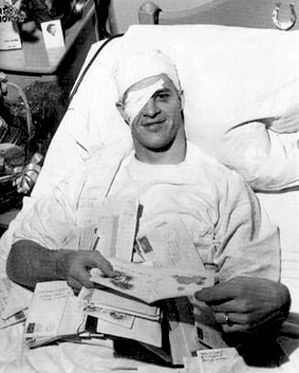


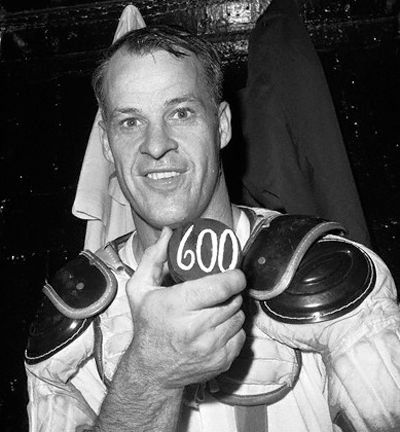
One of the most dominant players in NHL history, Howe would finish in the top five in league scoring for twenty straight seasons.
Teamed with linemates Sid Abel and Ted Lindsay, "The Production Line" would dominate the NHL and lead Detroit to first place in the regular season standings for each of the four seasons they played together from 1948-49 to 1951-52, a span that would include a pair Stanley Cup Championships in 1950 and 1952. So dominant was the line that they finished first, second and third in league scoring in 1949-50, led by Lindsay's 78 points in 69 games.
Howe would not be around to lift the Stanley Cup in 1950, having suffered a fractured skull earlier in the playoffs, which required emergency surgery to relieve the pressure.

Howe would return to form the following season of 1950-51, scoring 86 points to win the scoring title by 20 points over his nearest competition, the first of seven times he would win the Art Ross Trophy.
Howe would continue throughout the 1950's to accumulate championships and awards, winning the Stanley Cup in 1950, 1952, 1954 and 1955, the Art Ross Trophy as scoring champion from 1951-1954 and 1957, and the Hart Memorial Trophy as the league MVP in 1952, 1953, 1957, 1958 and 1960.

In 1960 Howe registered an assist in a 2-0 win over the Toronto Maple Leafs to score his 1,000th NHL point, the first player in the 44 year history of the league to reach that milestone and he did it in only his 938th game. It would be another eight years before Jean Beliveau would become the second 1,000 point player and another 20 years before Howe would score his final point. Remember, Howe already had 14 years in the league behind him at this point!

1963 would see Howe capture both the Art Ross and Hart Trophies once more and in 1965 Howe would score his 600th NHL goal in a game versus the Montreal Canadiens, becoming the first player in NHL history to record 600 goals. It would take another seven years until Bobby Hull would become the second to 600 in 1972.

In 1968-69, aided by the recent NHL expansion to 12 teams which created a longer schedule of games against some admittedly weaker opponents, Howe achieved his one and only 100 point NHL season with 44 goals and 58 assists for 103 points.
Howe would play two more seasons for Detroit, which included becoming the first player to reach 1,000 assists early in the 1970-71 season, his last with the Red Wings prior to retiring after the season due to a chronic wrist injury. He then took a job with the club's front office and was prepared for a life as a retired hockey player.
In the meantime, a new professional league came into being, the World Hockey Association. The league began with the 1972-73 season and included a franchise in Texas, the Houston Aeros. For the 1973-74 season, the Aeros had signed brothers Mark and Marty Howe to a pair of four-year, $400,000 contracts in early June of 1973 and two weeks later, they lured the boys' father and NHL legend, the now 45-year-old Gordie, who had already been inducted into the Hockey Hall of Fame the previous year following his retirement from the Detroit Red Wings after 25 seasons. It's safe to say that Howe's 1687 games of NHL experience was greater than the rest of the Aeros roster combined.
Today's video section has plenty of great footage and begins with the "Legends of Hockey" profile of Gordie Howe.
Howe would play two more seasons for Detroit, which included becoming the first player to reach 1,000 assists early in the 1970-71 season, his last with the Red Wings prior to retiring after the season due to a chronic wrist injury. He then took a job with the club's front office and was prepared for a life as a retired hockey player.
In the meantime, a new professional league came into being, the World Hockey Association. The league began with the 1972-73 season and included a franchise in Texas, the Houston Aeros. For the 1973-74 season, the Aeros had signed brothers Mark and Marty Howe to a pair of four-year, $400,000 contracts in early June of 1973 and two weeks later, they lured the boys' father and NHL legend, the now 45-year-old Gordie, who had already been inducted into the Hockey Hall of Fame the previous year following his retirement from the Detroit Red Wings after 25 seasons. It's safe to say that Howe's 1687 games of NHL experience was greater than the rest of the Aeros roster combined.
"My only regret is I'm sorry I'm not the Gordie Howe I was ten years ago to fulfill the goals the Aeros have in store for me. It's not too often an individual gets a second chance and that's what the Aeros have given me," Howe said. "A chance to play with my sons."
The addition of the Howe's gave the league a huge boost in credibility and exposure and allowed the legend of Mr. Hockey Gordie Howe to continue to grow. He had surgery to improve his bad wrist and relished the opportunity to play with his sons. Gordie also ensured that his son's would have plenty of time and space to learn their craft professionally, as any player who laid a big hit on Mark or Marty was sure to be paid back with interest by Gordie at the first available opportunity!
His game in Houston was a model of consistency, as he picked right up where he left off with 31 goals, including the 800th of his professional career. Additionally, his 100 points in 1973-74 were good for third overall in WHA scoring as the Aeros had the best record in the league by 11 points.
Additionally, Gordie was also named the league's Most Valuable Player in 1974, a trophy that would be renamed in his honor in 1976, while he was still an active player! In the playoffs that season Houston swept the Jets in four, survived an all out war with the Minnesota Fighting Saints in six games to advance to the Avco Cup Finals. Once in the finals, they swept the Chicago Cougars in four straight, giving the Aeros their first WHA title and Howe his first championship since 1955 with Detroit.
Additionally, Gordie was also named the league's Most Valuable Player in 1974, a trophy that would be renamed in his honor in 1976, while he was still an active player! In the playoffs that season Houston swept the Jets in four, survived an all out war with the Minnesota Fighting Saints in six games to advance to the Avco Cup Finals. Once in the finals, they swept the Chicago Cougars in four straight, giving the Aeros their first WHA title and Howe his first championship since 1955 with Detroit.
The original expectation in 1973 was that Gordie, who also signed a four-year contract, would play one year and then move into the Aeros front office. That was not to be however, as Gordie returned for a second WHA season. While Larry Lund led the club with 108 points, Gordie duplicated his output from the season prior with 99 points while Mark Howe contributed 76 points from the blueline after 79 the year before.
The Aeros again won the West Division with the league's best record by 14 points and dispatched the Cleveland Crusaders in five and the San Diego Mariners in four prior to sweeping the Nordiques in the finals to defend their title and become the first repeat winner in WHA history on this date in 1975.
Howe would once again lead the Aeros in scoring in 1975-76 with 102 points, 26 clear of his son Mark and Frank Hughes, but would only place 10th in the now wide-open WHA.
The following season of 1976-77 saw Gordie limited to 62 games and 68 points but he yet again reached a milestone never before achieved by a professional hockey player as he scored his 900th career regular season goal in March of 1977. Fittingly, his son Marty earned an assist on the landmark goal.
Howe was quoted as saying the puck was "aimed well, shot bad, and went in good." Howe was actually more concerned with getting his 903rd goal, as it would give him 20 for the season, continuing a streak which dated back to the 1949-50 season, 26 seasons in all. He would reach that mark, finishing the year with 24 goals in all.
Prior to the 1977-78 season, with their four year contracts having now expired, all three Howes moved en masse to the New England Whalers where Gordie's streak would extend to 27 seasons, as he would score 34 times to lead the Whalers in goals, as well as points in 1977-78. He would just miss out on extending the streak again in 1978-79 by the slimmest of margins at the age of 50, when he scored 19 while being limited to 58 games, his first season of less than 60 games since 1949.
Howe would play one final season with the Whalers, now renamed he Hartford Whalers as one of the conditions of their entry into the NHL. His 15 goals that season would push his final NHL career total past 800 with 801 and make his final professional total 975, thanks to his 174 goals while in the WHA.
While Wayne Gretzky would garner the headlines for breaking Howe's NHL record with his 802nd goal on March 23, 1994, his combined professional total between the WHA and NHL stands at 940, 35 short of the legendary Howe's 975.
Today's featured jersey is a 1954-55 Detroit Red Wings Gordie Howe jersey. Howe and the Red Wings would win their third Stanley Cup of Howe's career following the 1954-55 season. This sweater can be traced back to that era by the lack of sleeve numbers, which did not appear until later thanks to the advent of television coverage.
Bonus jersey: Today's bonus jersey is a 1976-77 Houston Aeros Gordie Howe jersey. We have seen a number of different variations for Gordie Howe Aeros jerseys, including his full name on the back with serifed letters as seen on today's featured jersey, "G. HOWE", also using the same serifed letters, and finally his full name on the back with standard, sans-serif block letters.
Research indicates that the sans-serif lettering was not actually worn on the ice at any time by the Aeros during Howe's days with the club and that the "G. Howe" variation was from the pre-season of Howe's first year with Houston, meaning all genuine Howe Aeros game worn jerseys should have his full name on the back in the serifed font.
Extra bonus jersey: Today's extra bonus jersey is a 1977-78 New England Whalers Gordie Howe jersey. Their original green road and white home 1972-73 WHA jerseys featured a "W" with a harpoon in a circle, which was simplified to just a larger "W" and harpoon for the Whalers second season of 1973-74 with the addition of gold trim to their green and white colors. Those jerseys survived relatively unchanged for the remainder of their days in the WHA.
Upon entering the NHL, and undergoing their name change from "New England" to "Hartford" they club modernized their jerseys, debuting a clever new logo of a "W" topped off by a whale tail, with the negative space creating a subtle "H" for those clever fans who studied it long enough. The addition of blue trim made for an attractive set of jerseys, still topped off by the "Pucky the Whale" shoulder patches, worn since day one in the WHA.
Here is an unusual find, Gordie Howe on the TV game show, "What's My Line?" being questioned by Hogan's Heroes' Colonel Klink Werner Klemperer and Soupy Sales. Howe's legendary toughness is apparent, as he is unfazed at being interrogated by a Nazi prison camp commandant.
Gordie tells Keith Olberman how hockey used to be and to respect your elders.
Next up, Gordie discussing coming out of retirement to join Houston with baseball great Tom Seaver.
Were very excited to share this rare footage of the Aeros winning the 1974 Avco Cup over the Chicago Cougars.
Don't miss the exciting, miraculous conclusion of the same game between the Aeros and Jets on December 5, 1975.
Here is footage from the 1979 WHA All-Star Game, when Gordie famously played on a line with youngster Gretzky.
Subscribe to:
Comments (Atom)

